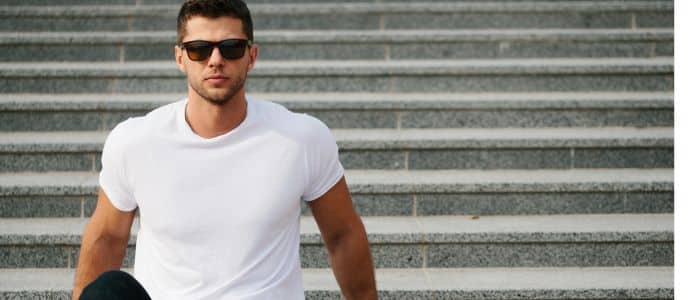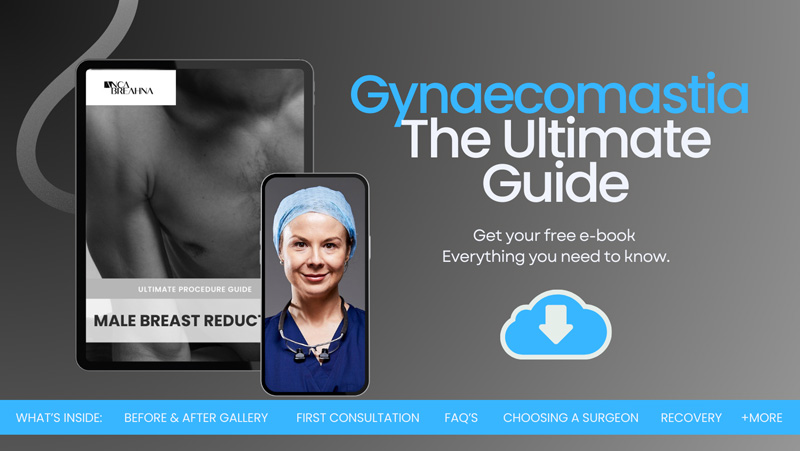
What to Expect after Your Gynaecomastia Surgery
Gynaecomastia, a condition characterised by the enlargement of breast tissue in men, can impact an individual’s self-esteem and body image. While the condition itself is often the source of much emotional distress, the path to recovery following gynaecomastia offers hope for those seeking to regain confidence and comfort in their own skin.
In this blog, Chester Consultant Plastic Surgeon Anca Breahna aims to discuss the recovery after gynaecomastia process, providing a roadmap for what to expect and how to navigate the journey towards healing.
Download the Guide to Gynaecomastia Surgery

What Is Gynaecomastia Surgery
Gynaecomastia surgery, medically known as male breast reduction, is a procedure designed to remove excess breast tissue and fat, resulting in a more traditionally masculine chest contour. The surgery involves liposuction and/or glandular tissue excision, depending on the nature and extent of the gynaecomastia. The success of this procedure lies not only in the skill of the surgeon but also in the hands of the patient, who must carefully follow post-operative instructions to ensure optimal healing and outcomes. Learn more about the Types of Gyno – Glandular vs. Fatty Tissue Gynaecomastia to understand which type you might have.
The Recovery Timeline after Gynaecomastia
The recovery journey from gynaecomastia surgery is marked by several milestones, beginning with the initial post-operative period and extending through the weeks and months that follow. Initially, patients can expect a relatively quick recovery phase, with many able to resume normal daily activities within a few days. However, this rapid initial recovery does not signify the end of the healing process.
In the first week, discomfort and swelling are common, but these symptoms are manageable with prescribed medication and the use of compression garments. The importance of these early days cannot be overstated, as they lay the foundation for the healing process.
As the weeks progress, patients will notice a gradual reduction in swelling and an improvement in the contours of their chest. It is during this time that adherence to post-surgery guidelines becomes crucial. Activities that could jeopardise the results, such as heavy lifting or vigorous exercise, should be avoided until Anca gives the green light, usually around the 4-6 week mark.
By the end of the first month, most of the acute recovery will have taken place, but the healing journey is far from over. Full recovery and the final results of the surgery may not be fully apparent until up to a year post-operation, as the body continues to adjust and heal at a cellular level.
Essential Recovery Tips
Recovery from gynaecomastia surgery is a critical phase that demands careful attention to ensure the best possible outcomes. Here are some essential tips to guide you through this period:
- Post-Surgery Care: Adhering to Anca’s post-operative instructions is vital. This includes taking prescribed medications to manage pain and prevent infection, attending all follow-up appointments, and properly caring for your incision sites. Keeping the surgical area clean and dry helps minimise the risk of infection and facilitates the healing process
- Compression Garments: Wearing compression garments is important for reducing swelling, providing support to the surgical areas, and helping the skin adjust to the new body contour. These garments should be worn as directed by Anca, for a period of 4 to 6 weeks. They not only aid in healing but also in achieving the desired aesthetic outcome by ensuring even contouring and minimising the risk of fluid accumulation
- Activity Restrictions: It’s essential to avoid strenuous activities and heavy lifting for the first few weeks post-surgery. Such activities can increase blood pressure and lead to complications such as bleeding or swelling. Gradually reintroduce physical activities as recommended by Anca, usually starting with light walking to promote circulation. Listen to your body and avoid any exercise that causes discomfort or strain in the chest area
- Massage Techniques: Around three weeks after surgery, once Anca gives the go-ahead, begin gentle massage techniques on the treated area. Massaging helps to soften the scar tissue, reduce swelling, and improve skin elasticity. It can also aid in the more uniform distribution of remaining fat cells, leading to smoother contours. Anca can guide you on the specific techniques and frequency of massage
- Healthy Diet and Hydration: A balanced diet rich in vitamins and minerals supports the body’s healing process. Foods high in vitamin C, zinc, and protein can promote wound healing and tissue regeneration. Staying well-hydrated is equally important, as water plays a crucial role in healing and maintaining skin elasticity. However, avoid excessive salt intake to prevent unnecessary swelling
- Rest and Sleep: Adequate rest is vital for recovery. Sleep helps the body heal and recover faster. Ensure you’re getting enough sleep each night and try to sleep on your back to avoid putting pressure on the chest area, which can affect the surgical results
- Avoid Smoking and Alcohol: Smoking can significantly hinder the healing process by impairing blood flow, while alcohol can increase the risk of swelling and bleeding. It’s advisable to avoid these substances for a few weeks before and after surgery to ensure a smooth recovery
Common Post-Surgery Recommendations
Following surgery, there are several common recommendations that, if adhered to, can significantly enhance your recovery experience and outcomes:
- Skin Care: Taking care of your skin is essential during the recovery process. Avoid exposing the surgical scars to direct sunlight for at least a year, as UV rays can darken the scars. Use a high-SPF sunscreen if you need to be out in the sun. Anca may also recommend scar treatment creams or gels to promote scar healing
- Posture: Maintaining good posture is surprisingly important after gynaecomastia surgery. Good posture helps to reduce tension on the surgical incisions, promotes a more natural healing process, and can improve the final appearance of your chest. Additionally, adopting a confident posture can have positive psychological benefits, helping you to embrace your new appearance
- Emotional Support: Recovery is not only physical but also emotional. The changes in your body can evoke a range of emotions, from relief and happiness to anxiety about the healing process. It’s important to have a support system in place, whether it’s friends, family, or a support group for individuals who have undergone similar procedures. Don’t hesitate to seek professional help if you’re struggling with your mental health during this time
- Patience and Realistic Expectations: Finally, it’s crucial to have patience and maintain realistic expectations about the recovery process and the final results. Healing is a gradual process, and it may take several months to a year to see the full benefits of your surgery. There may be fluctuations in swelling and contour during this time, which is normal. Trust in the process and keep in close communication with Anca to address any concerns that may arise
Overcoming Potential Recovery Challenges during Gynaecomastia Recovery
Recovering from gynaecomastia surgery is generally straightforward, but like any surgical procedure, it can come with its set of challenges. Being prepared and knowing how to address these potential issues can make your recovery smoother and more comfortable:
Seroma and Haematoma Formation
One of the common concerns following gynaecomastia surgery is the formation of seromas or haematomas. A seroma is a pocket of clear bodily fluid that can accumulate under the skin, while a haematoma is a collection of blood outside of blood vessels. Both conditions are generally preventable with proper care and compression, but they can occur due to overactivity or inadequate compression post-surgery.
Wearing your compression garment as directed by Anca is important in preventing these issues. It applies even pressure to the surgical area, reducing the likelihood of fluid accumulation. Small seromas and haematomas may resolve on their own, but larger ones might require drainage or additional treatment.
Sensation Changes
Changes in sensation around the surgical site, including numbness or hypersensitivity, are common and usually temporary. Nerves can be bruised or stretched during surgery, leading to these sensation changes.
Most sensory changes gradually improve over weeks to months as the nerves heal. Gentle massage can help desensitise the area and promote nerve recovery. If the changes in sensation are significant or persist, discuss them with Anca during follow-up visits.
Scarring
Scarring is an inevitable part of surgery, and its extent varies depending on the individual’s healing process and the surgical technique used.
Follow Anca’s advice on scar care. This may include using silicone sheets or gel, which can help flatten and fade scars. Keeping scars out of the sun and applying sunscreen when exposed can prevent them from becoming more noticeable. Remember, scars typically become less conspicuous over time.
Emotional Adjustments
The psychological impact of physical changes should not be underestimated. Some individuals may experience a period of adjustment or even depression post-surgery.
It’s important to discuss any feelings of sadness or anxiety with Anca or a mental health professional. Joining support groups where you can share experiences and receive encouragement from others who have undergone similar procedures can also be beneficial.
Patience throughout the Process
Recovery is not instantaneous, and optimal results take time to manifest. Swelling and shaping of the chest will continue to evolve in the months following surgery.
Keep in mind the reasons you chose to undergo gynaecomastia surgery and the positive outcomes you’re anticipating. Celebrate the small milestones in your recovery and maintain open communication with Anca about any concerns or questions that arise.
FAQs about Gynaecomastia Surgery
Who is an ideal candidate for gynaecomastia surgery?
- Ideal candidates for gynaecomastia surgery are individuals who are in good general health, have realistic expectations about the outcomes, and suffer from persistent enlarged breast tissue that has not responded to alternative treatments or lifestyle changes. It’s also important that candidates are not significantly overweight, as weight loss might naturally reduce the appearance of gynaecomastia. Emotional stability and understanding the procedure’s limitations are crucial for a satisfactory outcome.
How long does gynaecomastia surgery take, and is it performed under general anaesthesia?
- Gynaecomastia surgery takes between 1 to 2 hours, depending on the extent of the surgery and whether liposuction is also being performed. The procedure is commonly performed under general anaesthesia, ensuring that the patient is comfortable and pain-free throughout the surgery. In some cases, local anaesthesia with sedation may be an option, depending on the patient’s specific circumstances and the surgeon’s recommendation.
Can gynaecomastia return after surgery?
- While gynaecomastia surgery removes fat and glandular tissue, reducing the likelihood of recurrence, it is not a 100% guarantee against future development. Significant weight gain, steroid use, or certain medical conditions can potentially lead to a recurrence of gynaecomastia. Maintaining a healthy lifestyle and avoiding factors known to contribute to gynaecomastia can help minimise the risk of recurrence.
What are the risks associated with gynaecomastia surgery?
- As with any surgical procedure, gynaecomastia surgery carries certain risks, including infection, bleeding, adverse reactions to anaesthesia, and complications related to the healing process. Specific risks related to gynaecomastia surgery may include uneven contours, changes in nipple or breast sensation, and scarring. Discussing these risks with Anca before the procedure can help set realistic expectations.
Will I need to take time off work or school after gynaecomastia surgery?
- Most patients will need to take some time off from work or school to recover from gynaecomastia surgery. The exact amount of time will depend on the nature of their job or academic obligations and the extent of the surgery. Generally, patients can return to non-strenuous activities within a week, but it may take several weeks before they can resume more physically demanding tasks.
How should I prepare for gynaecomastia surgery?
- Preparation for gynaecomastia surgery includes following Anca’s instructions regarding medication adjustments, fasting before surgery, and arranging for someone to drive you home post-procedure. It’s also advisable to prepare your recovery area at home, ensuring you have easy access to essentials and a comfortable place to rest. Avoiding smoking and alcohol for a specified period before and after surgery can also enhance your healing process and outcomes.
Further Reading about Procedures with Consultant Plastic Surgeon Anca Breahna
- Read more about When Can I Exercise after Gynaecomastia
- Read more about How to Get Rid of Puffy Nipples in Men
- Read more about Tummy Tuck / Abdominoplasty
- Read more about Male Breast Reduction Surgery
- Read more about Blepharoplasty / Eyelid Lift Surgery
- Read more about UK’s Most Popular Plastic Surgery for Men
- Read more about How to Get Rid of Man Boobs – Causes and Treatment Options
- Read more about When Can I Exercise after Gynaecomastia
Medical References about Recovery after Gynaecomastia
- Gynaecomastia Surgery (Male Breast Reduction) – Cleveland Clinic
- Gynaecomastia Surgery Recovery – American Society of Plastic Surgeons
- The benefits of a good gynaecomastia surgery postop routine – American Society of Plastic Surgeons
- Breast reduction (male) – NHS
- Treatment of Severe Gynaecomastia (Grade III) by Resection of Periareolar Skin


 Ms Anca Breahna, PhD, MSc, FEBOPRAS, FRCS (Plast) is a highly regarded Consultant Plastic Surgeon specialising in the field of Aesthetic and Reconstructive Plastic Surgery. Anca performs a range of
Ms Anca Breahna, PhD, MSc, FEBOPRAS, FRCS (Plast) is a highly regarded Consultant Plastic Surgeon specialising in the field of Aesthetic and Reconstructive Plastic Surgery. Anca performs a range of 